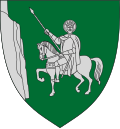Szob | |
|---|---|
 Roman Catholic Church | |
| Coordinates: 47°49′10″N18°52′09″E / 47.81944°N 18.86930°E | |
| Country | |
| County | Pest |
| District | Szob |
| Area | |
• Total | 20.07 km2 (7.75 sq mi) |
| Population (2015) | |
• Total | 2,730 |
| • Density | 136/km2 (352/sq mi) |
| Time zone | UTC+1 (CET) |
| • Summer (DST) | UTC+2 (CEST) |
| Postal code | 2628 |
| Area code | (+36) 27 |
| Website | www |
Szob (German : Zopp an der Donau, Slovak: Soba) is a town in Pest county, Central Hungary, Hungary. It is just south and east of the Slovak border on the north bank of the Danube.
Contents
Szob is on a major electrified rail connection from Bratislava [1] and a major railway border crossing into Hungary. The border is located between Szob and Štúrovo. On 21 December 2007, all border controls ceased as Hungary and Slovakia became part of the Schengen Area.
Szob is known to Americans for its forced-labor camp which held former US Congressman Tom Lantos, during much of World War II.









